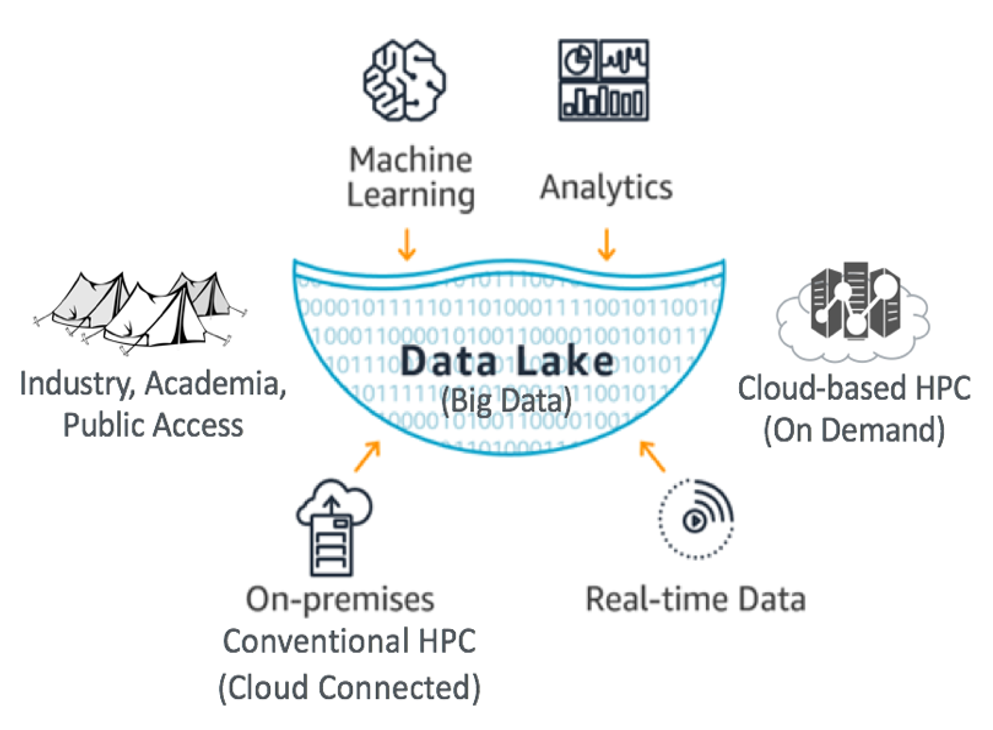OEDI Data Lakes
What is a data lake?
A data lake is a collection of curated and diverse datasets built to accelerate accessibility and collaboration. Data Lakes typically hold especially large or complex raw, processed, or supporting data files chosen by the contributing researchers. The lake enables sustained access to large data files, often through partnerships with a variety of cloud vendors.
Information flows into the Data Lake from a variety of sources: private industry, laboratories, analytic tools, use cases, research reports, and more. Next, the Data Lake's content is curated so that it is consistent and standardized. Once a Data Lake is curated it flows outward to the public and becomes universally accessible. Public access opens the door to potential collaboration between publication authors, researchers, universities, high schools, startup companies, and other innovators.
The availability and visibility of the Data Lakes remove barriers to innovation. The Data Lakes reduce duplication of effort by having a centralized location and reduces the cost of storage and analytics of large data sets. New insights and innovations flow outward from the lake, creating opportunities for even more rounds of research and development.
What belongs in the OEDI data lake
The data lakes are an alternative storage model to the conventional data submission model, intended for especially large or complex datasets. There is no exact requirement to denote what is considered especially large or complex, but generally, if your dataset is on the order of terabytes in size (or larger), if it has multiple nested layers (e.g., hierarchical data format), or if it is cloud-optimized, it could be a good fit for the data lake. We recommend storing data files and complex metadata files in the data lake, and saving scientific reports, supporting media, and links to online documents for the submission form that will accompany your data lake submission.
Universal Accessibility
Our open architecture is designed for universal access and dissemination of big data. Data Lakes can be accessed via our cloud partners. There are a few ways to utilize Data Lakes. Jupyter notebooks are a common option for utilizing Data Lakes datasets. However, there are many options for processing Data Lakes.
- Jupyter notebooks (example)
- Google Earth Engine
- Direct access to Data Lakes (Requires a cloud account.)
- Data Lake Viewer (Currently only AWS)
- Native cloud command line tools (AWS, Google, Azure)
- Mounting the data as a local read-only drive in a cloud-built computer cluster. Requires same availability zone.

Typical Costs of Data Access
Data Lakes are accessible in a variety of ways based on user's needs and budgets. Jupyter notebooks can be accessed free of charge and many operations can be run right in the cloud. Depending on the workload and mechanisms, costs can be under $1 USD with AWS Athena. For more resource intensive operations opt for Google's BigQuery, On-demand or Flat-rate pricing, to process SQL queries on terabytes of data in a matter of seconds. SageMaker Studio Lab provides a fully managed machine learning service, free of charge, with no credit card or AWS account needed. See example use cases.
- Download datasets via data-catalog viewer, users may process data in ways they see fit. Alternatively, batch download via Amazon's Command Line Interface.
- Free for end users.
- Learn More.
- Highly Scalable Data Service (HSDS) is a REST-based product and solution for reading and writing complex binary data formats within an object-based storage environment, such as the Cloud.
- Free for end users.
- Learn More.
- Access data with S3 Tools and APIs to analyze datasets.
- Free for end users.
- Learn More.
- Athena is an interactive query service offered by AWS that makes it easy to access data in Amazon S3 using SQL.
- AWS Athena can be used for a small fee, often less than $1.
- Learn More.
- Google BigQuery is a serverless, highly scalable data warehouse that comes with Google's built-in query engine.
- BigQuery offers two pricing models (On-demand and Flat-rate pricing) for running queries, often less than $0.10
- Learn More.
-HPC (High Performance Computing) instances are ideal for applications that benefit from high-performance processors, such as large simulations and machine learning workloads.
- Multiple pricing models, often less than $10.
- Learn More.
- The SageMaker Studio provides a web-based integrated development environment (IDE) where users can see and interact with all ML workflows on AWS.
- End user costs are often less than $20. Use Amazon SageMaker Savings Plan to reduce costs by up to 64%, compared to On-Demand pricing.
- Learn More.
- Amazon SageMaker Studio Lab is a free machine learning (ML) development environment that provides the compute, storage (up to 15GB) and security to learn and experiment with ML.
- Free for end users.
- Learn More.
How to submit data to the OEDI data lakes?
If you are interested in submitting your data to the OEDI data lakes, check out our data lake submission process page.
Data Lakes
0
Data Lakes
0
of Data
0
Downloads
(this year)
| Submission | Availability | Size | Status | Data from |
|---|---|---|---|---|